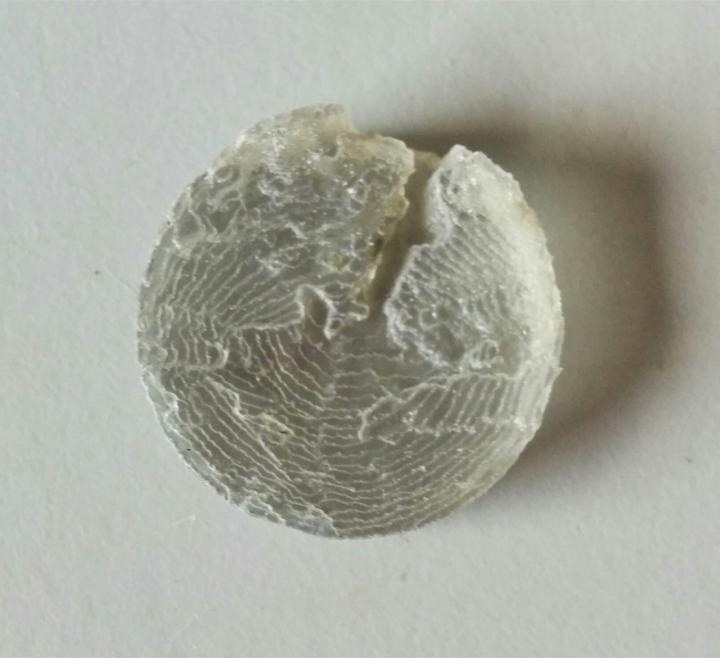Mar 1 2017
 This is a fabricated sample before absorber deposition. Credit: Brown et al.
This is a fabricated sample before absorber deposition. Credit: Brown et al.
A team of researchers from the University College London, inspired by the limitations of the piezoelectric array technologies traditionally used for ultrasonics, went ahead and explored an alternative mechanism for producing ultrasound via light, also called the photoacoustic effect.
By coupling this effect with 3D printing, the team succeeded in generating sound fields with particular shapes for potential use in drug delivery and biological cell manipulation.
Mechanical stress is generated by piezoelectric materials in response to an applied electric field, and this results in an accurately controllable and usable force that can, for instance, be used to develop sound waves. Complicated electronics and increased numbers of extremely small individual components, which are difficult and expensive to manufacture, are both needed to achieve this control with standard piezoelectric arrays.
In contrast, the photoacoustic effect occurs when a material absorbs a short pulse or modulated source of light, producing a sound wave. The recent issue of Applied Physics Letters, from AIP Publishing, has published a report presented by the team. This report highlights that the team’s work deals with the application of photoacoustic effect to control ultrasound fields in 3D.
One useful feature of the photoacoustic effect is that the initial shape of the sound that's generated is determined [by] where the light is absorbed. This can be used to create tightly focused intense points of sound just by depositing an optical absorber on a concave surface, which acts like a lens.
Michael Brown, Doctoral Student, University College London
Generally, it is possible to manufacture samples with almost any surface shape by using a transparent material and a 3D printer.
"By depositing an optical absorber on this surface, which can be done via spray painting, a sound wave of nearly any shape can be created by illuminating this sample with a laser," Brown said. "If you carefully tailor the design of the surface and therefore the shape of the acoustic wave, it's possible to control where the sound field will focus and even create fields focused over continuous shapes. We're using letters and numbers."
In theory, this is of specific importance because the potential to control the shape of the wavefront enables an increased degree of control over the resulting field. The wavefront here refers to the surface over which the sound wave has a steady phase, to some extent like the edge of the wave.
But actually designing a wavefront that generates a desired pattern becomes more challenging as the complexity of the target increases. A clear 'best' design is only available for a few select cases, such as the generation of a single focus.
Michael Brown, Doctoral Student, University College London
In order to overcome this limitation, the team "developed an algorithm that allows users to input a desired sound field in 3-D, and it then outputs a 3-D printable surface profile that generates this field," Brown said. "Our algorithm allows for precise control of the intensity of sound at different locations and the time at which the sound arrives, making it quick and easy to design surfaces or 'lenses' for a desired application."
By developing a lens designed to produce a sound field in the shape of the number 7, Brown and his colleagues illustrated the effectiveness of their algorithm. Following the illumination of the lens by a pulsed laser, the sound field was recorded by the researchers and the desired "7" was clearly seen with high contrast.
"It was the first demonstration of generating a multi-focal distribution of sound using this approach," Brown said.
A number of potential applications are available for the customized optoacoustic profiles developed by the team. "Highly intense sound can cause heating or exert forces on objects, such as in acoustic tweezers," Brown said. "And similar single-focus devices are already being used for cleaving cell clusters and targeted drug delivery, so our work could be useful within that area."
Additionally, the researchers also show interest in the effects of propagating through tissue, which brings about changes to the shape of the wavefronts. These change are caused by differences in the speed of sound.
If the structure of the tissue is known beforehand via imaging, our approach can be used to correct for these aberrations. Manipulating the shape and time during which the focused sound is generated can also be useful for the maneuvering and controlling biological cells and other particles.
Michael Brown, Doctoral Student, University College London
In the future, Brown and his team plan to investigate the application of other light sources and what benefits they could offer.
"One limitation of our work was the use of a single-pulsed laser," Brown said. "This meant that the temporal shape of the sound generated from the sample was only one short pulse, which limited the complexity of the fields that could be generated. In the future, we're interested in using alternative modulated optical sources to illuminate these devices."